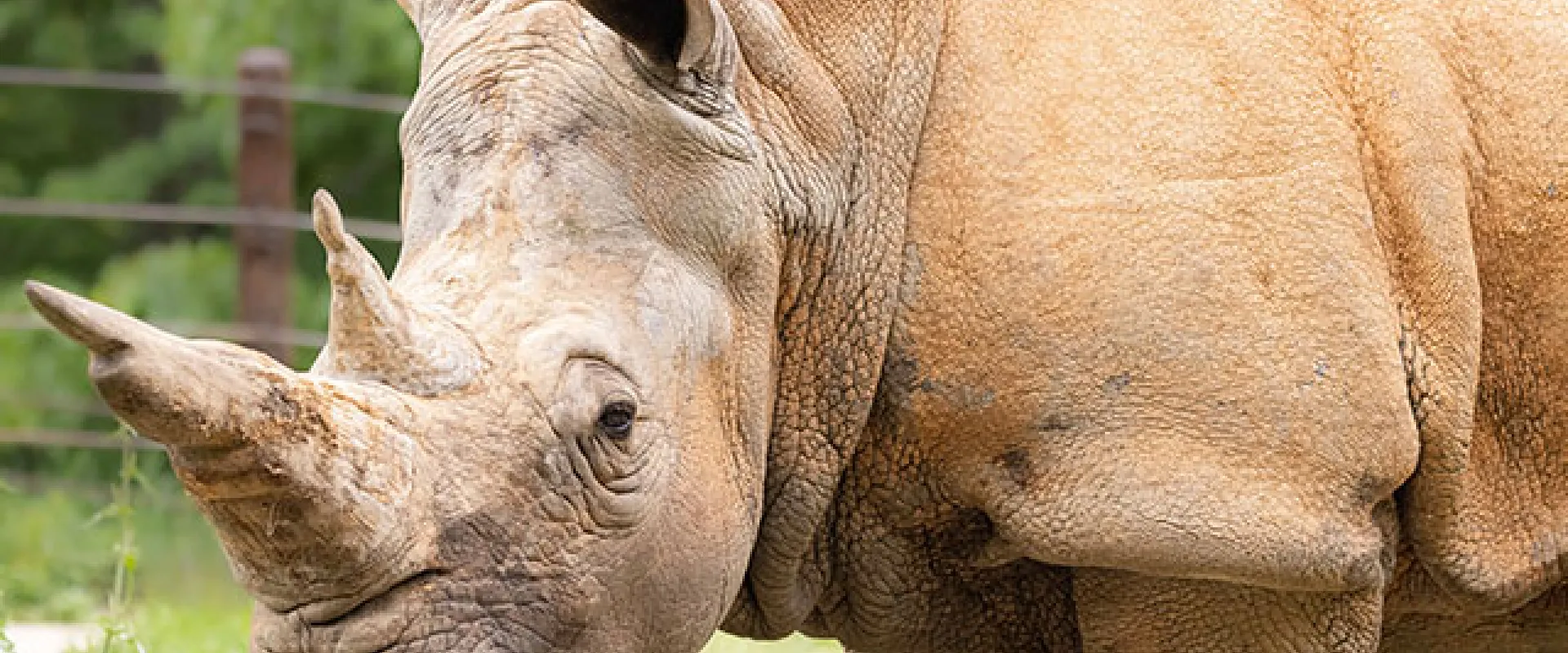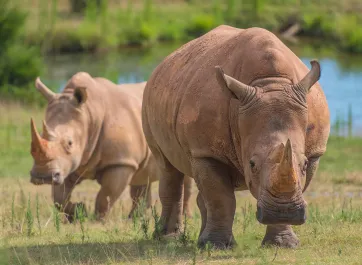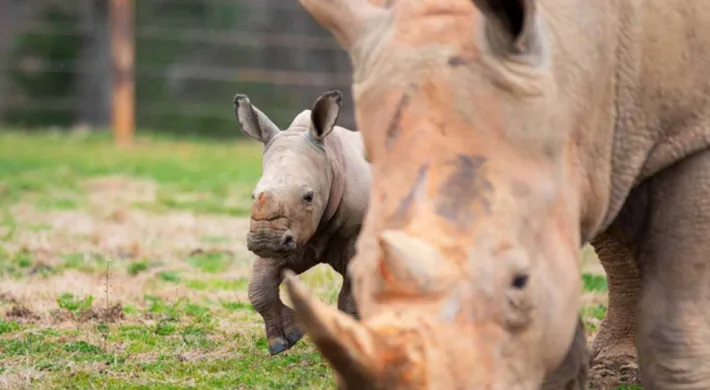Additional images and video are located here. All credit North Carolina Zoo. Free to use in broadcast, online and in print
Asheboro, N.C. – Sept. 16, 2022 - Olivia, a southern white rhinoceros who has lived at the North Carolina Zoo for more than 30 years, passed away on September 15.
Olivia, 54, had lived at the North Carolina Zoo since 1987 and arrived as a breeding pair with male rhino Stan, although no offspring were born.
In later years, Olivia and Stan lived together at the Zoo’s spacious rhino annex (off view from the public) in retirement for several years until Stan died in 2019.
Since then, Olivia was reintroduced to the other animals on the Zoo’s 40-acre Watani Grasslands and took on the role of “Great Auntie” to the younger rhinos. Southern white rhinos are the most social of the rhino species and live together in groupings called “crashes.”
As one of the oldest female rhinos in the Association of Zoos and Aquariums (AZA) venues, Olivia served as an ambassador for the plight of rhinos in the wild, whose populations are threatened by poaching and habitat loss. Rhinos in the wild live into their early 30s and can live into their early 40s under human care. That Olivia lived to the age of 54 is a testament to the extraordinary care she received through the years.
“Due to her significantly advanced age, we have been closely monitoring Olivia for any signs of declining health for the past few years,” said Dr. Jb Minter, the Zoo’s director of Animal Health and Chief Veterinarian. “The culmination of several health conditions led to a significant decrease in her quality of life and her ability to get around comfortably. The animal care and veterinary teams then made the difficult decision to euthanize Oliva.”
"I will certainly miss Liv and her sassy attitude," said Zookeeper Anna Hinson, who cared for the rhino for several years. "Over the years, she mellowed quite a bit, and I wish the Zoo's newer keepers had been around to see ol’ Liv in her prime. Even in her golden years, it's truly remarkable how she stuck to her routine. I'll forever be richer for having worked with her."
Southern white rhinos were hunted to near extinction by the beginning of the 20th century for their horns, which some erroneously believe provide medicinal benefits. Rhino horn is made up of keratin, the same material that makes up human fingernails and hair. The threat faced by wild rhinos is very real. Today, populations in the wild (estimated between approximately 19,000-21,000) still face significant threats from poaching and habitat loss.
In addition to their work with the rhinos at the North Carolina Zoo, staff work on conservation projects in several countries in Southern Africa to save this species. Through SMART (Spatial Monitoring and Reporting Tool), the North Carolina Zoo is working to protect rhinos and other species in the wild. SMART is an app that allows national parks and other protected areas to better understand patterns of wildlife distribution and illegal activity and combat destructive activities like poaching.
The second-largest land mammal after elephants, southern white rhinos have two horns, grow to 12-13 feet long and up to six feet from hoof to shoulder, and weigh 4,000 to 5,000 pounds at full maturity. Olivia weighed approximately 3,200 pounds.
These gentle giants are herbivores and graze on grass, which helps maintain the diverse African grasslands, increase plant diversity and provide grazing areas for other animals that share their natural habitat: the savannahs of Africa. They have a similar diet at the Zoo, getting most of their food while grazing the 40 acres of the Watani Grasslands.
The North Carolina Zoo now has a rhino crash of eight females - Linda, Kit, Natalie, Abby, Nandi, Bonnie, Jojo and Mguu.
Donations in remembrance of Olivia and for rhino conservation around the world can be made by visiting online at N.C. Zoo Society Anti-Poaching Programs.
###
About the North Carolina Zoo
At the North Carolina Zoo, we celebrate nature. As the world’s largest natural habitat Zoo, we inspire a lifelong curiosity about animals for the hundreds of thousands of people who visit our Zoo each year. Our dedicated team of experts provides exceptional, compassionate care for the more than 1,700 animals and 52,000 plants that call our Park home. We also lead efforts locally and globally to protect wildlife and wild places because we believe nature’s diversity is critical for our collective future. The North Carolina Zoo invites all of our guests to witness the majesty of the wild in the heart of North Carolina and welcomes everyone to join in our mission to protect nature’s diversity. Visit NCZoo.org to begin your life-changing journey.
About the N.C. Department of Natural and Cultural Resources
The N.C. Department of Natural and Cultural Resources (NCDNCR) is the state agency with a vision to be the leader in using the state’s natural and cultural resources to build the social, cultural, educational and economic future of North Carolina. NCDNCR’s mission is to improve the quality of life in our state by creating opportunities to experience excellence in the arts, history, libraries and nature in North Carolina by stimulating learning, inspiring creativity, preserving the state’s history, conserving the state’s natural heritage, encouraging recreation and cultural tourism, and promoting economic development.
NCDNCR includes 27 historic sites, seven history museums, two art museums, two science museums, three aquariums and Jennette’s Pier, 39 state parks and recreation areas, the North Carolina Zoo, the nation's first state-supported Symphony Orchestra, the State Library, the State Archives, the N.C. Arts Council, State Preservation Office and the Office of State Archaeology, along with the Division of Land and Water Stewardship. For more information, please call (919) 814-6800 or visit www.ncdcr.gov.


